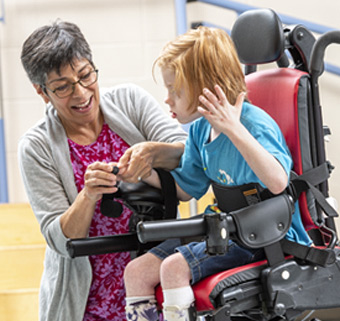 SATCo is a valuable tool to help clinicians determine just where a client needs trunk support in order to engage in a task or activity. The work of Butler et al. (2010)¹ demonstrated the validity of the tool and its ability to detect trunk weakness and postural control challenges. This approach to assessing the trunk is a paradigm shift; first, understanding that the trunk consists of multiple levels, and then recognizing the need for more targeted support in order to develop the postural control needed for function.
SATCo is a valuable tool to help clinicians determine just where a client needs trunk support in order to engage in a task or activity. The work of Butler et al. (2010)¹ demonstrated the validity of the tool and its ability to detect trunk weakness and postural control challenges. This approach to assessing the trunk is a paradigm shift; first, understanding that the trunk consists of multiple levels, and then recognizing the need for more targeted support in order to develop the postural control needed for function.
Clinicians can be mistaken about their client’s postural control and where that control actually is, due to the concept of open and closed chains (Saavedra et al., 2015).² The ability to complete functional tasks is contingent upon the client’s ability to use open and closed chains effectively and efficiently. The higher up on the trunk a client loses postural control, the quicker they close a chain to maintain postural control, which in turn limits their ability to use their head, arms and legs efficiently. An example of this would be a child sitting on a bench using both hands on the bench to maintain posture. It appears as though the child has the postural control to sit freely; however, that child is unable to use either hand to engage in an activity because she needs her hands to support her posture. The same is true for a student in a stander who is using cervical extension to hold his head up; closing the chain in that fashion limits the student’s ability to use his eyes to engage visually in a lesson or with a peer. For a clinician, observation of the client and their use of the open and closed chain principles is key to denoting the specific area of postural control loss and assist in making the decision on how to address it using supports. Supports can either be done manually or with adaptive equipment such as elevated trays, all dependent upon (1) where on the trunk the weakness occurs, (2) for what activity that control is needed and (3) the unique needs of the client.
The neutral vertical pelvis is key to postural control using the principles of SATCo. It allows for the client’s posture to align in the most advantageous position possible for function, and also allows the clinician to see where the control is lost during SATCo testing. Maintenance of the neutral vertical pelvis in standing and sitting is paramount when implementing any piece of adaptive equipment to mitigate postural control challenges. Adaptive chairs and therapeutic benches can be modified by adding SATCo strapping in order to get the client’s pelvis in neutral vertical. Standers require a firm support over the pelvis which could come in the form of an additional pad or other adaptation. An example would be an adaptive chair or a bench outfitted with the SATCo system strapping or the Rifton Mobile Stander with an additional pelvic pad.
Consider a student who is sitting on a bench during a circle time activity. Activities during circle time may require her to reach up and touch a screen or picture, activate a switch or hold the flag for the pledge. In this sample case, SATCo testing indicated that the child lost postural control at the mid thoracic level, which is at the mid-level of the rib cage. In order for the child to maintain postural control and use her arms and hands to touch the screen or hold the flag, she needs support at that mid thoracic level. As a clinician, how would you intervene so the child can participate in the circle time activity and engage in the instruction?
Intervention should include positioning the student in neutral vertical pelvis first, using the pelvic support system the Rifton Activity Chair supplies or a strapping system added to a bench or other adaptive seating. Additional support to mitigate the mid thoracic loss of control could come from (1) the paraprofessional supporting the student from behind with his/her hands at the lower end of the mid ribs after the pelvis is properly secured, (2) trunk prompts or (3) pool noodles and or a tray aligned at the mid thoracic level in order for the trunk to be stabilized. Now upper extremity use is possible.
As a clinician, use observational skills while having the student perform the task to “tweak” the positioning for optimal functioning. You may need to move supports up or down in order for the client to maximize their participation. These same strategies can be used at home for a younger child, and applied to a high chair or other adaptive seating, even a regular chair.
For the child who does not have head control according to SATCo testing, the same concepts apply: start with neutral vertical pelvis and apply supports high up on the trunk by using an elevated tray and or table in order for the arms to be supported. In this case, manual support may be difficult and mechanical supports more appropriate. Be aware that support needed can vary due to the variety of tasks a child may do at school or engage in at home. The complexity and variability of the task and environment will require careful observation to ensure optimal participation and success. An example of this concept is a student sitting in an adaptive chair at school for snack time where finger feeding is appropriate, versus sitting in the same chair in the cafeteria and using a spoon or fork to learn to self-feed with peers.
As a clinician, I have found SATCo to be highly effective for achieving a better understanding of our clients’ postural challenges, and as a means for implementing effective intervention. I would welcome you to learn more about this evidence-based approach that can be integrated with available adaptive products for clients with physical disabilities.
Back to Top** This post was originally published on http://www.rifton.com/adaptive-mobility-blog/blog-posts/2019/november/satco-adaptive-equipment-and-you

